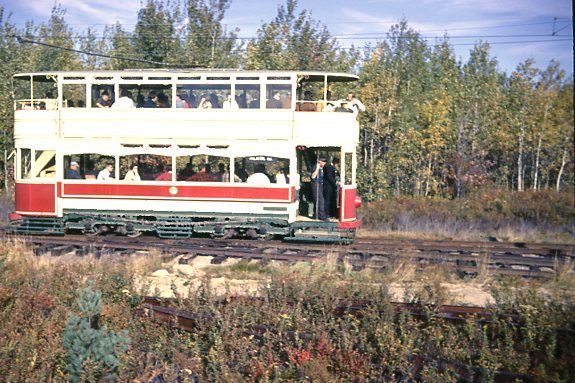
- Builder
- Blackpool Corp.
- Description
- Double-deck tram
- Secondary Use
- None
- Type
- City and Suburban Streetcars
- Year
- 1925
- Retired from Service
- 1954
- Acquired by the Museum
- 1954
- Note
- Seashore’s overhead department is working to raise the wire back to its proper height so that double deck cars can run again
- Fund
- 538
- Sponsor/Manager
- Robert Drye
Blackpool Corporation 144
From Blackpool, England
History
The seaside resort town of Blackpool had Britain’s first electric tramway in 1885, three years before Richmond, VA started the first successful, American electric streetcar system. Blackpool is the only British city to maintain tram service continually from the early days to the present. Blackpool Corporation built No. 144 in 1925 in its own workshops. No. 144 is one of 33 similar cars built by Blackpool between 1923 and 1927. These were termed Blackpool “standard” cars. The upper deck is covered but has open ends. The car is typical of British double deck cars used from the early 1900s until the 1950s. This car has a swivel shoe on its pole, allowing for automatic reversing at the terminals. Electrical equipment was constructed by the British Thomson-Houston Co., an affiliate of the General Electric Company of the U. S. Blackpool operated several tram lines, but the principal route ran 11 miles from Blackpool to Fleetwood along the Blackpool Promenade. In the 1950s, Blackpool replaced many older cars with more modern steel, Art Deco-styled double deck streetcars. The last standard car in regular service ran in 1966. As of 2018, the main route along the Promenade is in operation using modern trams. Older “heritage” trams also run on weekends.
The Mayor and Aldermen of Blackpool gave No. 144 to Seashore in 1954. No. 144 was Seashore’s first foreign car acquisition. During 1957-1959, Seashore replaced the roof and painted the car in its original red and cream paint scheme. Extensive rewiring and rehabilitation took place during the period from 2000 to 2015. The museum also repainted No. 144 in the green and cream paint scheme that it wore during most of its operating life. During the restoration, Seashore used extensive advice from the National Tramway Museum in Crich, England. No. 144 operated at Seashore in earlier years. However, the museum’s trolley wire has sagged somewhat since then, and No. 144 is now too high to operate under portions of Seashore’s trolley wire. Seven Blackpool standard cars have been preserved, including one in Blackpool.
Technical Information
- Seats: 78
- Control: B-510A
- Brakes: Dynamic / Hand
- Compressor: None
Trucks
- Number: 2
- Manufacturer: Preston
Motor
- Number: 2
- Manufacturer: BTH
- Model: 265C
Weight and Dimensions
- Length: 33’ 10.00"
- Width: 8’ 6.00"
- Height: 16’ 6.00"
- Weight: 33264 lbs.
Additional Images

Karl Johnson 10/15/66
© 1998 - 2026 New England Electric Railway Historical Society. All Rights Reserved.